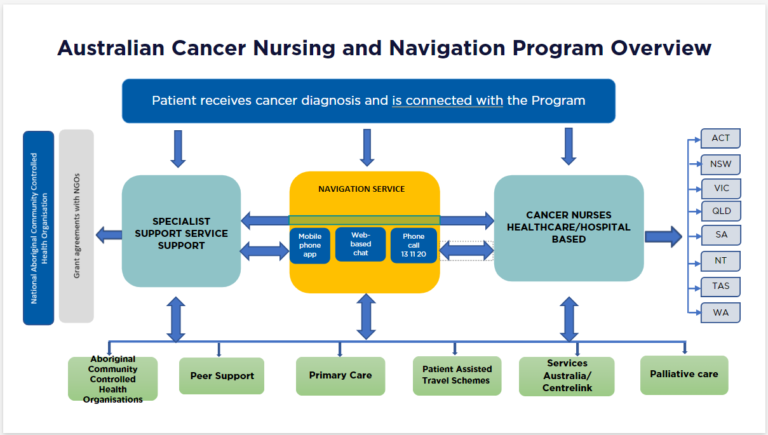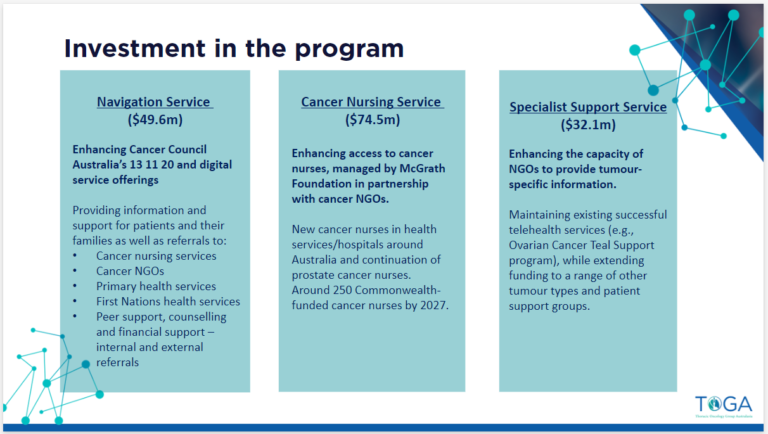The recent TOGA Annual Scientific Meeting highlighted the crucial role of Specialist Lung Cancer Nurses (SCLNs) in providing comprehensive care to patients with lung cancer. From managing pulmonary nodules to coordinating patient care, SCLNs make a significant difference in lung cancer healthcare and providing support to those living with lung cancer.
However, with the introduction of the Australian Cancer Nursing and Navigation Program (ACNNP) and the National Lung Cancer Screening Program (NLCSP), how will the workforce evolve to ensure that patients receive the best possible care?
What are SCLNs?
SCLNs are advanced practicing nurses who have become experienced through working in the field of lung cancer. Other healthcare practitioners who contribute to the workforce for lung cancer are Nurse Practitioners (who have done further qualifications), and nurses who have not necessarily aligned to a particular tumour type, or even to cancer.
Currently, there are 43 Specialist Lung Cancer Nurses across Australia (Lung Cancer CNCs), including 11 Lung Foundation Australia (LFA) SLCNs.

The Australian Cancer Nursing and Navigation Program
During her presentation, Anne Mellon, CNSA President, introduced the ACNNP, a $166 million by the Australian Government to ensure people affected by cancer have access to high-quality and culturally safe care irrespective of their cancer type or location. It should be noted that this is an integral part of the Australian Cancer Plan.

ACNNP Program Services
- Navigation Service: Despite the title of the ASM debate “Cancer Care navigators will outdo the need for specialist lung cancer nurses”, Cancer Care Navigators won’t replace our SLCN workforce. The Cancer Care Navigators component will primarily involve enhancing Cancer Council Australia’s 13 11 20 and digital service offerings, connecting people affected by cancer to information and support relevant to their needs.
- Cancer Nursing Service: This service will be managed by McGrath Foundation, in partnership with cancer non‑government organisations (NGOs). The service will gradually transition existing tumour-specific cancer nurses to the new all-cancer model. These nurses will be embedded within multi-disciplinary teams to help coordinate patient care, with NGOs supporting the onboarding of nurses with specific learning modules. Targeted expressions of interest were sent to public health services to identify where to place the first 100 federally-funded nurses by 2026-27. Ultimately, the all-cancer nurse service will deliver approximately 250 Commonwealth-funded all-cancer nurses to health and hospital services across Australia. There will be three SLCNs* in NSW who will transition to the McGrath nurse model, while 40 other SLCNs will remain in their roles.
- Specialist Support Services: Delivered by cancer NGOs, this will be tailored to the unique needs of people with cancer. LFA is one of 15 NGOs that will deliver this service and is currently developing a model of care. While this model of care will be used for the LFA nurses, it could also be adopted by other health services with SLCNs. LFA also continues to advocate for more SLCNs with States and Territories.
*These SLCNs are currently funded by the Federal government, and considered LFA Specialist Lung Cancer Nurses.
How does it optimise the nursing workforce?
Despite the humour in A/Prof Bryan Chan’s debate, he raised the pertinent point that SLCNs, who may attract higher salaries, are best reserved for positions that require the Advance Practice knowledge.
At his own regional site, a team of 14 clinical nurse consultants supports a hub-and-spoke model of care, including 4 other locations.
Similarly, Siobhan Dormer described in her presentation at the TOGA Lung Cancer Screening workshop the tasks and responsibilities when leading a nodule clinic.
These include:
- comparing nodule size to index scans for triaging by a respiratory physician,
- taking relevant medical history,
- chasing down imaging and other relevant information for accurate triaging,
- providing smoking cessation advice, and
- making case notes to ensure appropriate follow up was enacted after the referred service outcome.
The triaging is performed by the respiratory physician and involves referral to a high-risk nodule or nurse-led nodule clinic. This is a good example of how the front-facing nurse-led clinic distributes the workload among appropriately qualified healthcare professionals for maximal efficiency.
We know of other clinics led by SLCNs that deal with common side effects of cancer treatments, again matching these experienced professionals to higher duties.
The challenges
- Is this the solution to our current shortfall in the nursing workforce?
- Will it help address burnout?
- What will the role of the ‘McGrath nurse’ be?
- Does it mean that each lung cancer MDT will be serviced with a nurse?
We mourn the loss of 3 federally-funded SLCNs to the McGrath Cancer services model, which will reduce the number of SLCNs in Australia to 40.
However, as we expand our cancer healthcare, incorporating new treatments and practices, it is essential to explore innovative ways to optimise the role of SCLNs and ensure that patients with lung cancer receive the best possible care. The TOGA ASM provided valuable insights into these issues, and attendees have a limited time to access the OnDemand platform to see relevant presentations.
TOGA ASM Presentations mentioned in this article:
- Nurse-Led Pulmonary Nodule Clinic, Wednesday 31 July, presented by Ms Siobhan Dormer, Lung Cancer Clinical Nurse Consultant, Sir Charles Gairdner Osborne Park Health Care Group
- Navigating healthcare in Regional Settings, Thursday 1 August, presented by A/Prof Bryan Chan, Medical oncologist, Sunshine Coast University Hospital
- Clinical Quality Indicators in Lung Cancer Care, Friday 2 August, presented by Prof Fraser Brims, Respiratory Physician, Sir Charles Gairdner, Hospital, Curtin Medical School, WA, lead Lung Cancer Clinical Quality Data Platform
- Future of Lung Cancer Nursing in Australia. Friday 2 August, presented by Anne Mellon, President, CNSA
We extend our thanks to LFA for clarifying the shifting of the SLCN workforce for this piece.